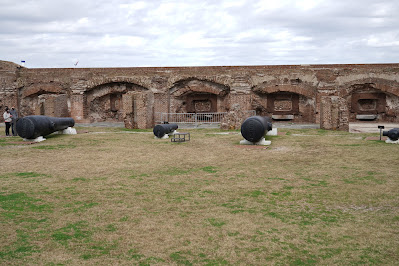We arrived at the Fort and began to look around.
The main draw are the various cannons around the fort, especially as all the interior exhibits are closed.
While there were plenty of cannon on the inside, firing out. There were several outside the fort shelling it with abandon.
During the Siege of Ft. Sumter (1863-1865) when the Union was trying to retake the fort, they shelled it extensively. Many shells passed into the fort and hit the interior of the walls rather than the exterior. Some of those shells remain within the walls of the fort.
Quite a few of these shells are still visible inside the walls where they impacted and failed to explode.
When the archeologists were excavating an area, they found a bunch of cannons still in their firing positions at the walls that had been purposely buried in place as obsolete.
Rather cool. The excavation is ongoing and more cannons and artifacts will likely be found. Entry to the area was prohibited.
That sign was a red flag to a Murphy.
That was not adequately Murphy-proofed.
We then went to the highest point in the fort to take in the view.
Then we saw a gun mount position that had been installed post-civil war to protect Charleston from attack from the sea.
The ferry was then set to depart, and we were all required to leave with it, so we boarded and left Fort Sumter. It's a very historic location yet a rather small fort that can be thoroughly explored in less than two hours, especially now that the museum and other interior spaces are closed.














2 comments:
It IS small, and imagine an errant or aimed cannon ball ricocheting around in there... (shiver)...
Old NFO: Yes, it had to be disheartening to be in a fort and instead of the walls keeping the artillery out, you've got shells and cannon balls bouncing around inside it and ending up sticking in the inside of the walls.
Post a Comment